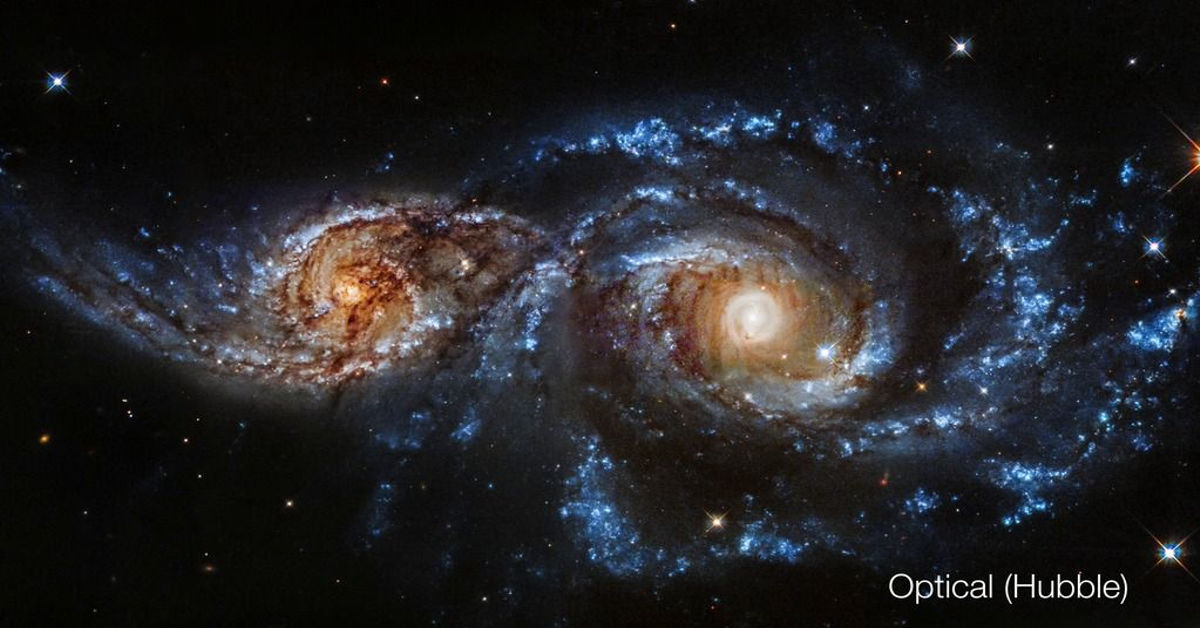In the vast universe, the Milky way and Andromeda are two massive neighbouring galaxies. The most interesting thing is that they will collide in future and merge with each other in the future. In this article, we will delve into the key differences and similarities between the Milky Way vs Andromeda galaxy, exploring their structures, compositions, supermassive black holes inside them, their origin and the inevitable cosmic event that awaits them.
Table of Contents
Basic Overview: Milky Way Vs Andromeda Galaxy
The Milky way is our home galaxy and Andromeda, also known as Messier 31, is our nearest major galaxy (nearest galaxy to Earth or Milky Way is Canis Major Dwarf Galaxy). Both are part of the Local Group and are 2.5 million light years away from each other. The shape of both galaxies is classified as barred spiral. The stars we see in the night sky with the naked eye are all part of the Milky Way, while Andromeda is the farthest astronomical object visible without aid.
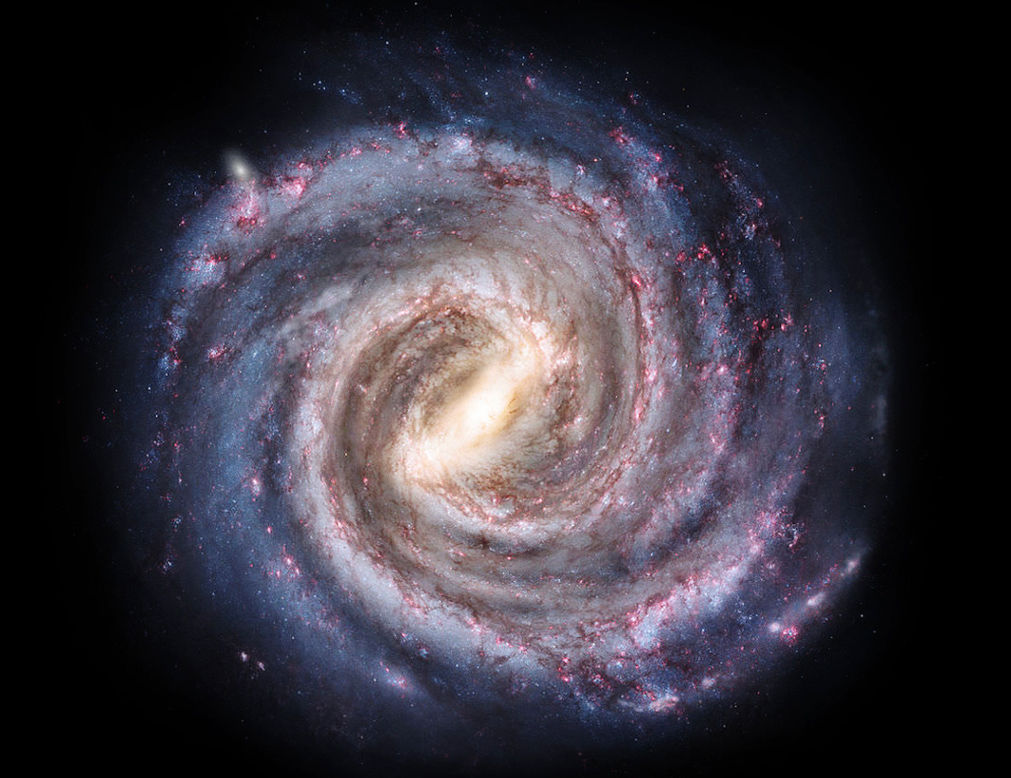
According to astronomers, the Milky Way is travelling at a speed of about 630 km/s (1,400,000 mph), with respect to the cosmological frames of reference. On the other hand, Andromeda is traveling toward the Milky Way at a speed of roughly 100–140 km/s (220,000–310,000 mph). In terms of number of stars and size of the galaxy, Andromeda is more than two times the quantity of Milky Way. However the mass of both the galaxies are nearly the same.
Size And Mass Comparison
In the discussion of Milky Way vs Andromeda Galaxy, the size and mass comparison plays a crucial role. The Milky Way has a diameter of around 100,000 light-years, with a mass between 900 billion and 1.5 trillion times that of the Sun. The escape velocity of the Milky Way, measured from our solar system’s position near the edge of the galaxy, is approximately 550 km/s (about 1.2 million miles per hour). This is the speed needed to break free from the gravitational pull of the entire galaxy.
In contrast, Andromeda is larger in size, spanning 200,000 light-years, making it the largest member of the Local Group. It has a mass of about 1.5 trillion solar masses. NASA Jet Propulsion Laboratory says that its mass is around the same as the Milky Way’s, or even less. According to a report published in the Monthly Notices of the Royal Astronomical Society, the Andromeda Galaxy’s escape velocity is approximately 470 km/s.
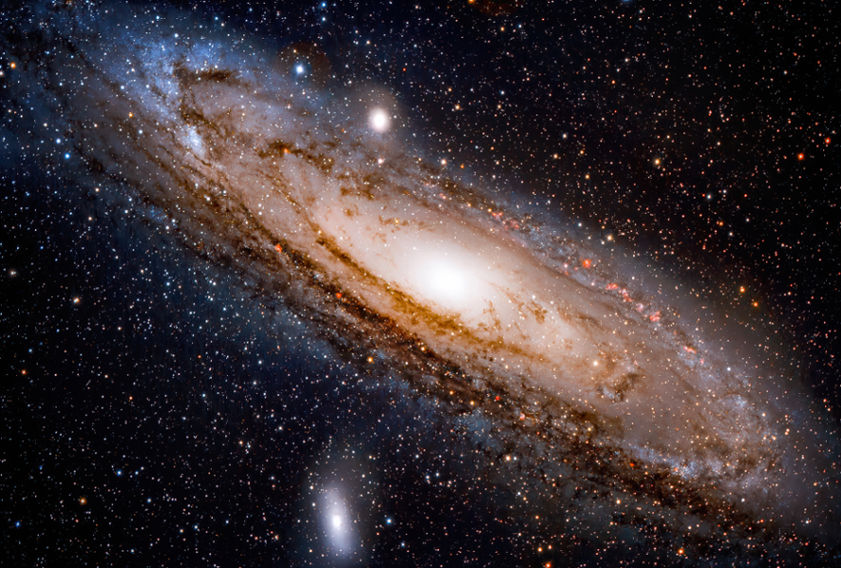
Composition Comparison: Milky Way and Andromeda
The Milky Way Galaxy is a vast, complex system composed of a diverse range of celestial objects and structures. It contains an estimated 100 to 400 billion stars, including our Sun, and at least the same or more number of total planets. The galaxy is dominated by dark matter, an invisible and mysterious substance that makes up around 85% of its mass, influencing its structure and rotation.
Our galactic centre contains a supermassive blackhole named Sagittarius A* (discussed later). Earth is located approximately 26,670 light years away from the galactic centre. In the inner region of our galaxy which is around 10,000 light-years of radius, there is dense concentration of mostly old stars in a roughly spheroidal shape, known as the bulge.
In total, there could be a billion neutron stars, 100 million stellar black holes, and ten billion white dwarfs in the Milky Way. It also hosts numerous globular clusters (spherical groups of stars bound by gravity) and around 50 satellite galaxies, including the Large and Small Magellanic Clouds, which are gradually merging with the Milky Way. The galaxy’s spiral arms are rich with gas and dust, fuelling the birth of new stars. Surrounding the galaxy is a vast halo of dark matter and sparse stars. Together, these components create the dynamic and evolving structure of our home galaxy.
The Andromeda Galaxy contains an estimated one trillion stars, significantly more than the Milky Way. It shares a similar structure with our galaxy, being a barred spiral with distinct arms rich in gas and dust, fuelling the formation of new stars and having dense star cluster in its core. At the core of Andromeda lies a supermassive black hole, Messier 31*, which is way bigger than Sagittarius A*. A 2005 study using the Keck telescopes revealed the presence of a galactic halo extending outward from the galaxy. The stars within this halo exhibit disorganised orbital paths, unlike the more orderly orbits of the stars in the galaxy’s main disk, moving at speeds of around 200 km/s.

The overall shape of Andromeda appears more S-shaped than a flat disk. The spiral arms of the Andromeda Galaxy are outlined by a series of HII regions (large clouds of ionized hydrogen gas found in galaxies). Andromeda is home to around 460 globular clusters and contains several satellite galaxies, including M32 and M110, which orbit it due to its immense gravitational pull. Similar to the Milky Way, dark matter plays a critical role in Andromeda’s mass and dynamics, making up most of its unseen mass. However, it is believed that Andromeda contains slightly less dark matter than the Milky Way.
Blackhole
Our galactic centre contains a supermassive blackhole known as Sagittarius A*. It is estimated to have a mass of more than 4 million solar masses. This supermassive black hole has an estimated diameter of 14.6 million miles (23.5 million km), according to calculations made by astronomers. Sagittarius A* is our closest supermassive black hole, situated about 26,000 light-years from Earth. It was identified by observing stars in the vicinity of the galaxy’s centre moving at extraordinarily high speeds, which suggested the presence of a large, invisible object.
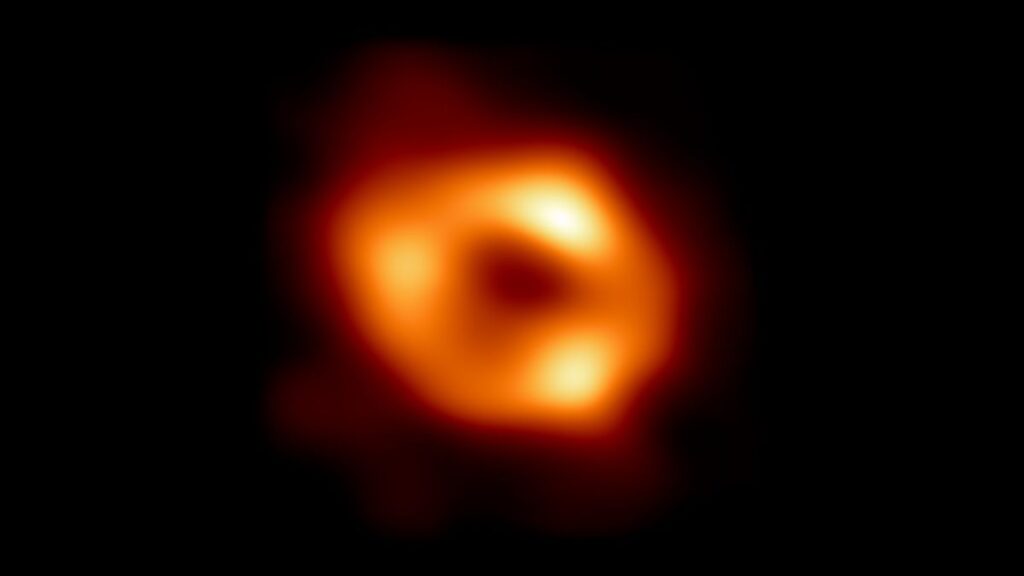
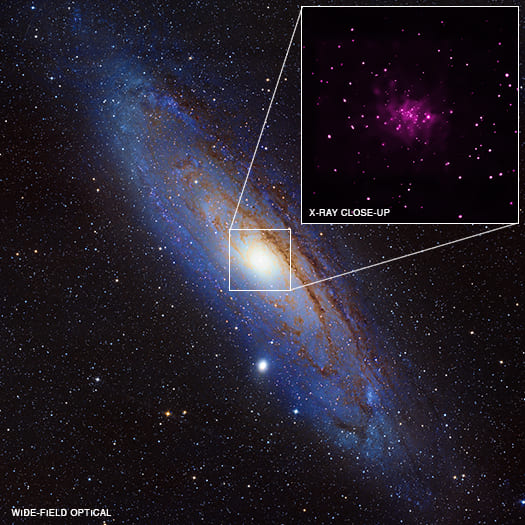
Credit: Chandra X-Ray Observatory
At the centre of the Andromeda Galaxy (Messier 31) lies a supermassive black hole similar to Sagittarius A*, known as Messier 31*. It has an estimated mass of around 100 to 230 million times the mass of the Sun (M☉), making it significantly larger than Sagittarius A*. Its presence was found out by the observations of the motion of stars near the galaxy’s core using radio wavelengths and in x-rays, which move at very high velocities due to the black hole’s intense gravitational influence.
Origin
The Milky Way began as one or more small dense regions in the early universe, shortly after the Big Bang, 13.61 billion years ago. Some of these dense areas gave rise to globular clusters, which are home to the oldest stars in the Milky Way. There’s a chance that other far-off galaxies contributed nearly half of the matter in the Milky Way.
Over the past 12 billion years, the Milky Way has collided with and absorbed neighbouring galaxies at least twelve times, absorbing its stars. Each galactic merger caused permanent changes to the form, size, and velocity of our galaxy, eventually shaping it into the distinctive spiral structure we recognise today. The collision and merger with the Kraken Galaxy, which occurred 11 billion years ago, was the largest among these events. The Milky Way continues to accumulate material from several minor galaxies, including the Large and Small Magellanic Clouds, which are two of its largest satellite galaxies.
It is believed that the Andromeda Galaxy formed about 10 billion years ago when a massive cloud of gas and dust collapsed under its own gravity. Over time, the material clumped together to form stars and spiral arms.
Only with the invention of strong telescopes in the early 1900s, astronomers were able to resolve the Andromeda spiral nebula into individual stars. The question of whether Andromeda was part of the Milky Way or a separate galaxy was debated until the 1920s, when Edwin Hubble resolved the controversy. He discovered that the Andromeda Galaxy exists outside our Milky Way, using observations of Cepheid variable stars within Andromeda.
Collision of Milky Way and Andromeda: Milkomeda
The collision between Milky Way and Andromeda Galaxy is an inevitable event predicted to occur in approximately 4 to 5 billion years. As both galaxies are the two largest members of the Local Group, they are being drawn toward each other by mutual gravitational attraction. Currently, Andromeda is moving at a speed of 100–140 km/s (220,000–310,000 mph) toward the Milky Way.
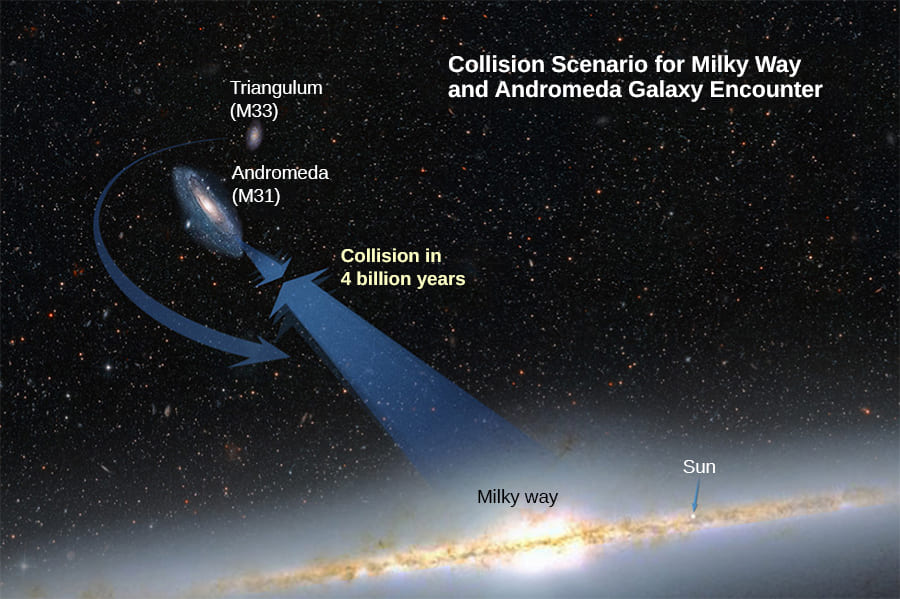
When the two galaxies collide, their stars will likely pass by each other due to the vast distances between them, but the gas and dust in each galaxy will interact, leading to the formation of new stars. Over the course of several billion years, this cosmic interaction will reshape both galaxies, eventually merging them into a single, larger elliptical galaxy often referred to as Milkomeda or Milkdromeda.
It is currently unknown what would happen to Earth and the Solar System in the case of a collision. There is a slim chance that the Solar System may either join the Andromeda Galaxy or escape from the Milky Way before the galaxies unite. This event will mark a major transformation in the structure of our cosmic neighbourhood.
Conclusion: A Cosmic Comparison
When comparing the Milky Way vs Andromeda Galaxy, there are many similarities and dissimilarities between them. Both galaxies are roughly the same age, and their internal structures and astronomical bodies are quite similar in terms of mass. However Andromeda is a much bigger galaxy in terms of stars, planets, supermassive blackhole size and diameter. Both galaxies are currently assimilating smaller galaxies and have done so in the past. Ultimately, the upcoming collision between the two galaxies promises to reshape our cosmic neighbourhood in ways we can only begin to imagine.
